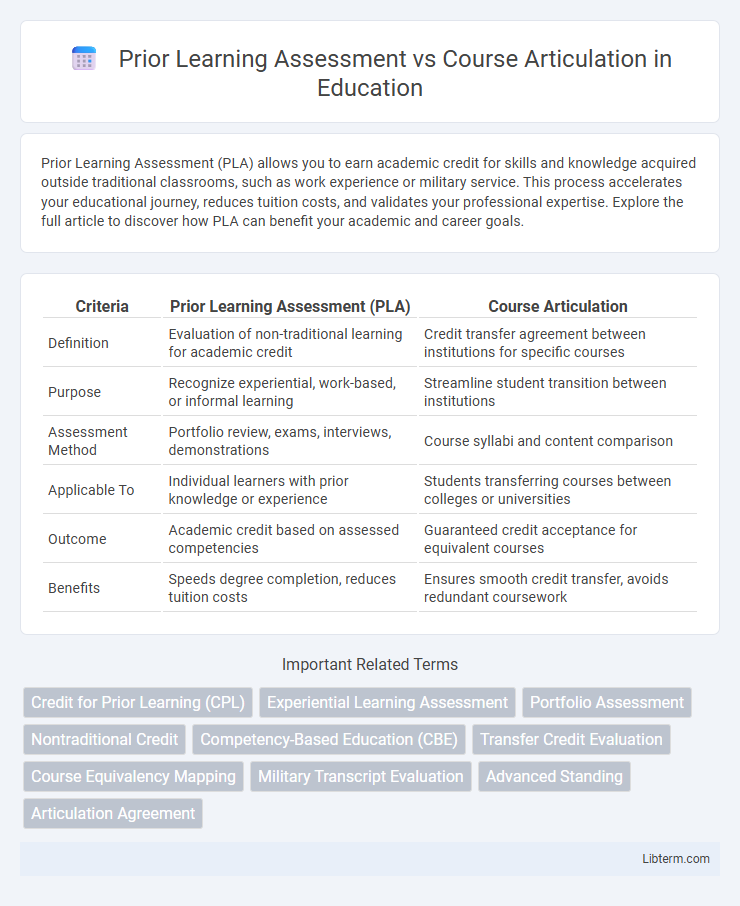Prior Learning Assessment (PLA) allows you to earn academic credit for skills and knowledge acquired outside traditional classrooms, such as work experience or military service. This process accelerates your educational journey, reduces tuition costs, and validates your professional expertise. Explore the full article to discover how PLA can benefit your academic and career goals.
Table of Comparison
| Criteria | Prior Learning Assessment (PLA) | Course Articulation |
|---|---|---|
| Definition | Evaluation of non-traditional learning for academic credit | Credit transfer agreement between institutions for specific courses |
| Purpose | Recognize experiential, work-based, or informal learning | Streamline student transition between institutions |
| Assessment Method | Portfolio review, exams, interviews, demonstrations | Course syllabi and content comparison |
| Applicable To | Individual learners with prior knowledge or experience | Students transferring courses between colleges or universities |
| Outcome | Academic credit based on assessed competencies | Guaranteed credit acceptance for equivalent courses |
| Benefits | Speeds degree completion, reduces tuition costs | Ensures smooth credit transfer, avoids redundant coursework |
Introduction to Prior Learning Assessment (PLA)
Prior Learning Assessment (PLA) is a process that evaluates and recognizes college-level knowledge gained outside traditional academic environments, such as work experience, military service, or independent study. It enables students to earn academic credit by demonstrating their competencies through various assessments, reducing time and cost toward degree completion. Course articulation, by contrast, involves the formal evaluation and transfer of credits between educational institutions to ensure that courses align and satisfy equivalent requirements.
Understanding Course Articulation
Course articulation involves formally recognizing and transferring specific academic credits between educational institutions based on equivalent course content and learning outcomes. This process ensures that students receive appropriate credit for prior coursework without redundant study, streamlining their educational progression. Understanding course articulation is essential for optimizing degree pathways and facilitating transparent credit transfer policies across colleges and universities.
Key Differences Between PLA and Course Articulation
Prior Learning Assessment (PLA) evaluates an individual's existing knowledge and skills gained outside traditional education to award academic credits, while Course Articulation aligns completed courses between institutions for credit transfer. PLA focuses on personal experiential learning evidence, such as work experience or certifications, whereas course articulation relies on formal course equivalencies and syllabus comparisons. Understanding these distinctions is essential for effectively navigating credit recognition in higher education.
Benefits of Prior Learning Assessment
Prior Learning Assessment (PLA) enables learners to earn academic credit for knowledge gained outside traditional classrooms, accelerating degree completion and reducing educational costs. PLA recognizes diverse experiences such as work, military training, and independent study, offering a personalized pathway and validating practical skills. This approach enhances student motivation and increases access to higher education by rewarding previously acquired competencies efficiently.
Advantages of Course Articulation
Course articulation offers clear advantages by ensuring seamless credit transfer between institutions, reducing redundancy and accelerating degree completion. It provides students with a structured pathway by outlining equivalent courses and recognized academic standards, enhancing academic planning and consistency. This process supports institutional collaboration, maintaining curriculum quality and fostering student retention.
Eligibility Criteria for PLA and Articulation
Eligibility criteria for Prior Learning Assessment (PLA) typically require learners to demonstrate relevant work experience, certifications, or informal learning that aligns with specific course outcomes. Course articulation demands established agreements between educational institutions ensuring that completed coursework meets equivalent academic standards for credit transfer. Both processes emphasize alignment with curriculum standards but differ in validation methods, with PLA focusing on experiential evidence and articulation on formal course equivalencies.
Processes Involved in PLA vs Course Articulation
Prior Learning Assessment (PLA) involves a detailed evaluation of an individual's experiential knowledge through methods such as portfolio review, standardized testing, and interviews to grant academic credit. Course Articulation processes include mapping and comparing course content, learning outcomes, and credit hours between institutions to approve transfer credits. PLA emphasizes individual competency validation, whereas course articulation standardizes credit equivalencies based on course alignment.
Impact on Student Transfer and Graduation
Prior Learning Assessment (PLA) accelerates student transfer and graduation by awarding academic credit for demonstrated knowledge gained outside traditional classrooms, reducing time and tuition costs. Course Articulation ensures seamless credit transfer between institutions by pre-approving equivalent courses, preventing credit loss and redundancy during transfer. Together, PLA and Course Articulation optimize credit recognition, improving student pathway efficiency and increasing timely degree completion rates.
Challenges and Limitations of Both Approaches
Prior Learning Assessment (PLA) faces challenges such as inconsistent evaluation standards and limited recognition across institutions, which can hinder credit transfer and student progression. Course Articulation often encounters limitations due to variations in curriculum design and institutional policies, causing misalignment in course equivalencies and delayed degree completion. Both approaches struggle with ensuring equitable access and maintaining academic rigor while addressing diverse student learning experiences.
Choosing the Right Path: PLA or Course Articulation
Choosing between Prior Learning Assessment (PLA) and Course Articulation depends largely on a learner's background and goals. PLA evaluates existing knowledge gained outside formal education to grant academic credit, making it ideal for professionals with relevant experience seeking accelerated degree completion. Course Articulation involves formal agreements for credit transfer between institutions, best suited for students transitioning between colleges wanting seamless acceptance of completed coursework.
Prior Learning Assessment Infographic

 libterm.com
libterm.com